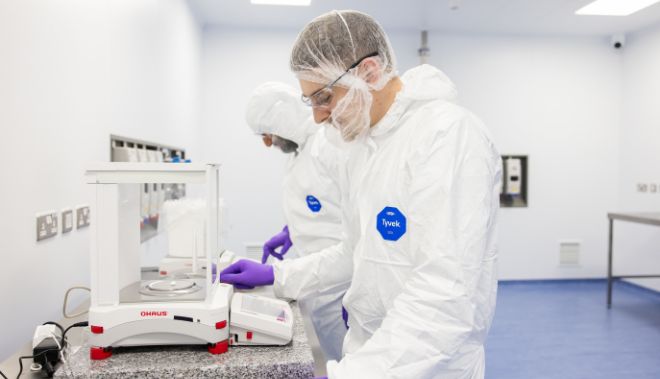An Overview of Early Phase Clinical Manufacture
- Clinical trials are a critical step in pharmaceutical development, ensuring the safety and efficacy of new treatments before they reach patients.
- They involve a series of rigorously designed phases with specific objectives and regulatory requirements.
- Small pharma companies often benefit from partnering with Contract Development and Manufacturing Organizations (CDMOs) for their expertise in navigating the complexities of clinical trials.
- CDMOs can provide support in various areas, including regulatory compliance, manufacturing, and patient recruitment.
- Understanding the UK’s regulatory landscape and selecting the right CDMO are crucial steps for small pharma companies to maximize their chances of clinical trial success.
Whilst undergoing research and development on a new chemical entity / new biological entity there are major initial objectives when planning the roadmap to clinic, submission and approval of the regulatory documentation, and ultimately dosage form administration in a human clinical study. In preparation for this key milestone event, a critical piece of information that must be thought through and developed is the target product profile and what it means for your study. Although you may anticipate changes to the final dosage form as your clinical program progresses, key factors that require definition even at this early stage include: dosage form type, dose, release profile, taste masking.

As your roadmap to clinic development progresses, the target product profile will need to be further developed and refined to consider a much wider range of attributes. When thinking about your target product profile, you should also be thinking about the patient as well as the science of delivery for your drug substance. The sooner these attributes are established the more focused and targeted your development strategy will become, but as mentioned in previous newsletters there is more than one method to enter your drug substance into clinical trial study and more than one objective for clients.
A first in human (FIH) study generally consists of a single ascending dose (SAD) and / or multiple ascending dose (MAD). When planning a FIH clinical study and undergoing your formulation development, you should also be planning and executing risk-based decision making. This consists of identifying activities which need to be undertook prior to clinical manufacturing, identifying potential factors involved with each activity and creating decisions accordingly to ensure risk mitigation. It is important to note that you can’t predict everything and when taking a risk you must be prepared, as it may indeed play out causing you further trouble than if you had planned a more cautious route originally.
The Planning Timeline Prior to Early Phase Clinical Manufacture
Active Pharmaceutical Ingredient Availability and Procurement
In a vast number of FIH studies it is this factor that regularly becomes the rate determining step. Initially you will calculate that you only require small quantities for you limited clinical dosing. The clinical requirements at this stage are often dwarfed by the amounts required for analytical method development and validation, stability testing, formulation development, reference and retains.
You need to be planning ahead to when the quantities required increase for the later phases of clinical manufacture. Any changes to the scale or route of manufacture could potentially influence or invalidate the previous trials; requiring bridging studies to be performed.
Analytical Methods
Transfer, development, and phase appropriate validation of all the necessary release test methods requires detailed planning. For early phase studies, developing an appropriate product specification and ensuring the methods where required are stability indicating, must be part of the project initiation at your CDMO. Analytical transfer and setup are usually one of the first major tasks on the project timeline as suitable analytical test methods must be in place to support the formulation development. Generally, the active pharmaceutical ingredient (API) supplier will have developed the analytical method for the API that can then be adapted for the product testing; promoting a good transfer by enabling communication between the API suppler and the CDMO is crucial.

Formulation Development
Depending on the complexity of your formulation and on the prior knowledge of the active compound the excipient compatibility study is a key task that should be risk assessed. Excipient compatibility studies are the mixing of the active drug substance and the likely excipients, which are tested after storage on accelerated conditions for a relatively short time (4 to 8 weeks).
If the FIH study is simply being conducted as powder-in-capsule (or a very simple formulation) and data already exists demonstrating that the active is stable and robust in all circumstances; the excipient compatibility study is sometimes omitted until a more definitive formulation is developed.
However, omission of the excipient study can on occasion backfire with unforeseen instability arising on the clinical batch; thus, reducing the product shelf life and availability of clinical supplies, potentially even requiring a recall. The time saved by omitting the excipient compatibility study at the start of the development campaign on a risk-based decision, can ultimately result in a serious loss of time and investment.
Excipient Compatibility Studies
Depending on the complexity of your formulation and on the prior knowledge of the active compound the excipient compatibility study is a key task that should be risk assessed. Excipient compatibility studies are the mixing of the active drug substance and the likely excipients, which are tested after storage on accelerated conditions for a relatively short time (4 to 8 weeks).
If the FIH study is simply being conducted as powder-in-capsule (or a very simple formulation) and data already exists demonstrating that the active is stable and robust in all circumstances; the excipient compatibility study is sometimes omitted until a more definitive formulation is developed.
However, omission of the excipient study can on occasion backfire with unforeseen instability arising on the clinical batch; thus, reducing the product shelf life and availability of clinical supplies, potentially even requiring a recall. The time saved by omitting the excipient compatibility study at the start of the development campaign on a risk-based decision, can ultimately result in a serious loss of time and investment.
Parallel Screening and Development Protocols
Time rather than science is often the major factor challenging the early phase development of compounds. Strategies need to be employed to fast track the development while ensuring safety, quality and efficacy are maintained.
Assuming that a simple drug-in-capsule approach is not suitable, there are risk-based strategies that can be taken to minimise the timeline. If an enabling technology is required, a number of companies offer small scale screening protocols that establish and / or review physico-chemical and biological data. Developing a small-scale evaluation utilising a range of enabling approaches and perform parallel screening using both in vitro and in vivo models, in a relative short time and with limited drug substances. Upperton’s UpperSolv™ process typically requires less than 10 grams of API to produce and evaluate up to 6 proof-of-concept formulations, using an in vivo pharmacokinetic model and perform stressed stability study data in less than 2 months.
Parallel screening and evaluation strategies such as this are more time / budget efficient, over the usual trial and error approach. If planned with targeted and well considered methodologies, this can provide a high level of confidence for selection of the clinical formulation.
Clinical Manufacture
After following all the steps prior to this, you will have garnered a lot of data on your formulation and API. Now you need to decide at what point you manufacture your clinical batch for FIH. This timeline has focused so far purely on the science lead up to clinical manufacture; there are other important trails of consideration that run in parallel to the science-based development. These include:
- Difference in regulatory requirements (e.g. IND or IMPD)
- Auditing and approval of the API supply.
- Approval of excipients and excipient suppliers.
- Establishing quality technology agreements.
- Establishing Quality Person to Quality Person agreements.
- Writing and submitting of regulatory documentation.
With these key considerations being decided upon in tandem with clinical product development, your business milestones and timelines should be within sight.
Engineering Batch
Once the clinical formulation(s) are selected, they should be tested for viability of the process at the required scale and more formal stability data generated at ICH conditions to support shelf-life assignment. Depending on the knowledge gained during formulation development, the extent to which the engineering batches are required and the amount of stability data that is generated before making a decision to proceed, is a regular subject of risk-based decision making.
Packaging and Labelling
This stage can often be overlooked in a roadmap to clinic but can add a significant time onto your manufacturing timeline. You must ahead of clinical manufacture have defined a packaging, labelling and logistics strategy for your clinical supplies.
Discover Upperton's Clinical Manufacturing Capabilities
We provide a flexible and dynamic approach to GMP manufacturing. From first in human (FIH) through to phase III clinical supplies manufacturing at our MHRA Approved and Home Office Approved (I-IV) GMP facility, Trent Gateway.
Conclusion
There are many steps in the roadmap to clinic. Throughout the whole process, you should practice risk-based decisions making. When thinking ahead about suppliers or contract service providers, it is a good idea to understand how they might interact with one another.
When choosing a contract service partner, it is imperative to base your choice on whom would suit your needs and business milestones throughout a roadmap to clinic. Areas to question in discussion are capabilities, capacity and expertise. The business and personnel should be: reactive, adaptive, have a work culture in line with your company (you’ll be working with them for a long period of time with regular communication), control of project management and timelines, trust and most importantly good communication.
Frequently Asked Questions
What is the significance of clinical trials in pharmaceutical development?
Clinical trials are essential for assessing the safety and efficacy of new treatments before they become available to patients. They are conducted in meticulously designed phases, each with specific objectives and regulatory requirements.
How can small pharmaceutical companies navigate the complexities of clinical trials?
Small pharma companies often partner with Contract Development and Manufacturing Organizations (CDMOs) to leverage their expertise in areas like regulatory compliance, manufacturing, and patient recruitment, thereby enhancing the likelihood of clinical trial success.
What is a Target Product Profile (TPP), and why is it important in early-phase clinical development?
A TPP outlines the desired characteristics of a drug product, including dosage form, dose, release profile, and taste masking. Defining these attributes early in development ensures a focused and targeted strategy, aligning the product with patient needs and scientific delivery requirements.